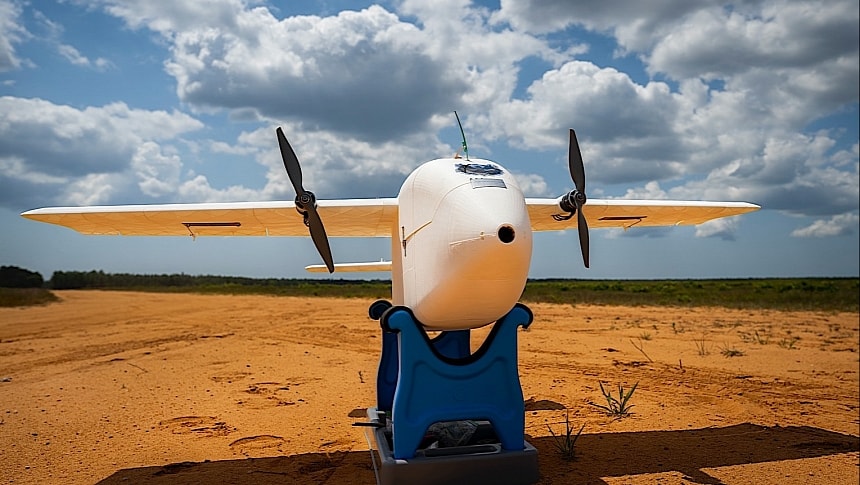It may not be pretty, big, or menacing, as many of the drones the U.S. Air Force (USAF) is presently using are, but this little contraption here has the honor of being (perhaps) the world's fastest drone when it comes to the time it needs to go from the drawing board to the sky.
The revelations of the war in Ukraine have made it obvious to the American military that drones are here to stay. Not the big, chunky ones used to spy and strike from afar, but small ones that can fly pretty much anywhere, barely visible, to drop weapons or supplies from above.
Seeing how both the Ukrainians and the Russians are using drones, the American military is now looking at ways of incorporating them into its strategy. But that's a very tricky thing to do, considering how extremely difficult it is to design a small drone that can perform so many different tasks in a difficult environment. Or is it?
If we are to judge by what a team of engineers comprising both USAF people and civilians managed to accomplish recently at the Eglin Air Force Base, it should be a breeze.
The team is called Black Phoenix, and it comprises USAF personnel working as part of the Blue Horizons fellowship (a USAF effort that's “part think-tank, part incubator"), and engineers from private company Titan Dynamics, a maker of small drones.
Their Blue Horizons fellowship idea wanted to see if it would be possible to build a drone from scratch and fly it in under 24 hours. A question that was more than answered at Eglin.
Using Titan's automated design software the team managed to create a virtual drone with specific (and undisclosed) characteristics – dimensions, weight, power, and payload capability – in just ten minutes.
Then, data was fed to 3D printers that spat out the component parts of the drone to be assembled by the team. The rest of the parts, the ones that couldn't be 3D printed, are off-the-shelf.
Once assembled these pieces of hardware became an eight-pound (3.6 kg) drone that can be configured for specific mission parameters.
As per the details shared by the USAF, six variants of the drone were tested over the course of a week, each of them being made using a rapid build and deployment method. Not all of them flew as expected (some crashed), but the tests proved that if need be the USAF could spit out a massive amount of multi-role drones in a very short period of time.
During the flight tests, the Black Phoenix team found that even when they crashed, the drones it built somehow retained functional autonomy hardware, meaning they could easily be put back together at a cost of up to $50. Needless to say, that could be a huge win for the military as well.
Research on the rapid-build drones will continue, and the team plans to show its findings in front of the Air Force Secretary and Air Force chief of staff as soon as this month.
Seeing how both the Ukrainians and the Russians are using drones, the American military is now looking at ways of incorporating them into its strategy. But that's a very tricky thing to do, considering how extremely difficult it is to design a small drone that can perform so many different tasks in a difficult environment. Or is it?
If we are to judge by what a team of engineers comprising both USAF people and civilians managed to accomplish recently at the Eglin Air Force Base, it should be a breeze.
The team is called Black Phoenix, and it comprises USAF personnel working as part of the Blue Horizons fellowship (a USAF effort that's “part think-tank, part incubator"), and engineers from private company Titan Dynamics, a maker of small drones.
Their Blue Horizons fellowship idea wanted to see if it would be possible to build a drone from scratch and fly it in under 24 hours. A question that was more than answered at Eglin.
Using Titan's automated design software the team managed to create a virtual drone with specific (and undisclosed) characteristics – dimensions, weight, power, and payload capability – in just ten minutes.
Then, data was fed to 3D printers that spat out the component parts of the drone to be assembled by the team. The rest of the parts, the ones that couldn't be 3D printed, are off-the-shelf.
Once assembled these pieces of hardware became an eight-pound (3.6 kg) drone that can be configured for specific mission parameters.
As per the details shared by the USAF, six variants of the drone were tested over the course of a week, each of them being made using a rapid build and deployment method. Not all of them flew as expected (some crashed), but the tests proved that if need be the USAF could spit out a massive amount of multi-role drones in a very short period of time.
During the flight tests, the Black Phoenix team found that even when they crashed, the drones it built somehow retained functional autonomy hardware, meaning they could easily be put back together at a cost of up to $50. Needless to say, that could be a huge win for the military as well.
Research on the rapid-build drones will continue, and the team plans to show its findings in front of the Air Force Secretary and Air Force chief of staff as soon as this month.






